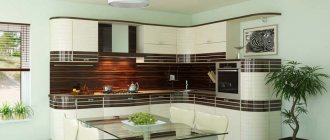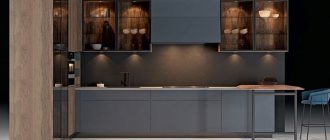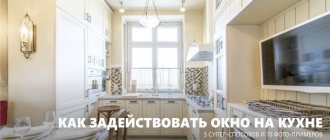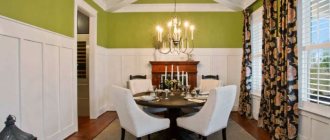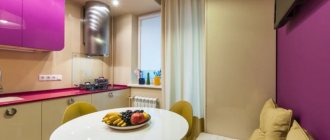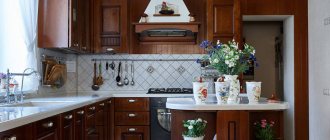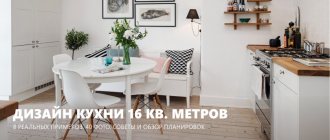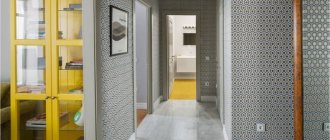Kitchen sets have now become extremely popular. The “calling card” of any kitchen is its façade.
The style and color of the front of the furniture and cabinet doors emphasize the unified design of the entire kitchen and are constantly in sight.
A careful approach to the search for furniture fronts for the kitchen interior will allow you to optimize the overall cost of the kitchen.
Key characteristics when choosing facades
Furniture in the kitchen is most often exposed to mechanical, thermal, chemical and other adverse effects.
Therefore, when choosing a material for a facade, it is very important to take into account a number of parameters:
- resistance to temperature changes (to avoid deformation of the facade in the slab area),
- moisture resistance of materials (to prevent facades from getting wet, they can be additionally covered with film),
- mechanical strength (when struck, no chips should appear).
In addition, it is desirable that the kitchen facade evokes positive emotions and is easy to clean.
Shelves on the wall for the kitchen: ideas on how to make them yourself, photos- Table restoration, tools, furniture preparation and work stages
- Do-it-yourself restoration of old chairs: disassembly, upholstery, seat, assembly, painting, decor, decoupage, photo
Decoration Materials
To create a beautiful and high-quality profile for kitchen facades, the material must be subjected to special processing, which often involves the use of additional components.
Melamine
This finishing method is often called lamination. This is due to the fact that in the first case, the material is first impregnated with melamine resin, which is a polymer. Then everything is compressed under pressure and temperature.
The second option assumes that a film is applied to the material, which, when heated, itself adheres to the surface.
- This method is very popular and widely used in furniture production.
- It allows you to protect the surface from the effects of the external environment, while maintaining the beautiful structure of the original material.
- It tolerates moisture and minor mechanical damage well.
Advice! This type of manufacturing can be considered the most optimal in terms of price and quality ratio.
Stainless steel facade
Veneer
Standard veneered facades for kitchen units are made from various materials, which are then covered with thin plates. They are made from hardwood, cut into thicknesses from 0.4 to 1.2 mm.
Commonly used are cherry, walnut, oak and beech.
Although for luxury furniture, veneer is made from teak, ebano, merabou, etc. Then the resulting strips are glued to the material using a special paste.
- Such fronts for kitchen cabinets are not particularly practical, especially if they are exposed to temperature and moisture.
- Often this type of finishing material is used together with others, resulting in quite good products.
- With the advent of modern technologies, this type of finishing began to be forgotten, although special plastic veneer is used in the manufacture of cabinet furniture from laminated chipboard.
- Also, 3D kitchen facades often install cabinets framed according to this type.
Advice! Do not place hot dishes or spill water on furniture made using veneer. This may cause the material to peel off.
Exclusive facades
Varnish
There are two types of this material. The first, when hardened, gives a glossy surface, the second a matte. Various dyes can also be added to the varnish, which give the material its own color and texture.
Many video instructions for creating furniture recommend first applying a layer of primer and paint to the wood or MDF panel, and only then applying varnish.
However, there are also technologies that make it possible to apply a photograph or drawing to the surface of the material, which is then torn with a transparent layer. This is how you get an original surface with various photos and even paintings.
The varnish repels water well, but does not tolerate mechanical stress well. At the same time, quite often you can find furniture on which this coating has faded over time.
Advice! Furniture coated with varnish looks very beautiful, but as professionals say, it is completely unsuitable for the kitchen. In such conditions, it will very quickly become unusable.
Modern kitchen façade design
Lighting requirements
Warm soft light is most suitable for natural wood.
Simple lampshades or sconces can most optimally accentuate the beauty of furniture facades, which should become one with the kitchen design.
- Straight kitchen design with cabinets up to the ceiling
- What material are kitchen sets made of?
- Kitchens with patina: decor options and tips on color combinations
Exclusive options
When you make kitchen furniture with your own hands, you want it to be made from the best materials and using the most modern technology.
At the same time, many craftsmen try to stand out and use very rare and exclusive materials.
- First of all, it is worth noting the natural stone. It is often used to make countertops, although with proper processing and good hinges it is also suitable for surface decoration. At the same time, the instructions recommend using hard rocks that will not crumble over time or deteriorate under mechanical stress.
- Polished stainless steel is also often used. It is reliable and resistant to all the difficulties associated with working in the kitchen.
- A special material called Microtouch deserves special attention. It is easy to clean and is resistant not only to high humidity, but also to mechanical stress. At the same time, its texture very much resembles natural leather, which makes the appearance of the kitchen facade stunningly beautiful, but its price is quite high, and the material itself is rare.
- You can often find facades made of special plastic or composite material.
Such kitchen furniture belongs to the elite category and costs accordingly. Although among it you can even find models that can be classified as Russian standard.
Classic design
Designers' opinion
Today, the most popular is the naturalness of the interior, which can best be emphasized by furniture facades made of natural wood.
When using dark shades in the design of the kitchen facade, you should give preference to light colors for painting the walls. And vice versa, a light kitchen set will be favorably emphasized by dark-colored walls.
Popular materials for decoration
Currently, there are a huge number of different types of materials for the manufacture of kitchen facades. However, some of them are basic and have been used for quite a long time. They are reliable, high quality and easy to maintain.
Wood boards
The most popular kitchen facades are made from so-called wood panels.
They are well known to consumers under the name chipboard or MDF.
- Such panels have a relatively inexpensive price, are well processed and have a pleasant appearance.
- However, it is worth noting that it is not very stable in high humidity and wears out quickly.
You should know! Some manufacturers, claiming that they use solid wood for their panels, actually use wood panels that are lined with veneer.
New kitchen cabinet fronts
Solid wood
This solid wood kitchen façade has always been considered elite. Only expensive wood species were used for its manufacture.
Nowadays, it is quite rare in its entirety, since most often this material is used to make panels or frames into which glass can later be inserted.
- This type of material looks very beautiful because it conveys the natural structure of wood.
- It has significant weight, which means that reinforced hinges must be used for its installation.
- Such kitchen facades are easy to use, but require perfectly dry wood during manufacture.
Advice! The array is obsolete, since there are completely different technologies that make it possible to produce quite beautiful things at minimal cost.
Kitchen facade made of solid wood
Glass
Quite often, solid glass panels are installed on kitchen modules without facades. At the same time, it can be subjected to additional processing, such as tinting or sandblasting.
Also popular are frames made of solid wood, in the middle of which ordinary glass is installed.
- This type of material is very good to use, but if the glass has been sandblasted, dirt often collects in its pores.
- Also, such kitchen facades are quite fragile, even when using special glass.
Glass facade
Advice! This type of material is best combined or used only for the upper sections. It all depends on the specific style and design of the kitchen.
Photos of furniture fronts for the kitchen
How do you like the article?
Conclusion
Thus, it becomes clear that there are a huge number of different materials and methods of processing them for the manufacture of kitchen furniture facades. All of them differ in their qualities, appearance and design. At the same time, such a concept as a classic can currently be realized from completely new components and technologies.
Therefore, before choosing a kitchen facade, you need to study all the advantages and disadvantages of each type and, based on your needs and financial capabilities, settle on a specific type of material and method of processing it.
Gallery
Did you like the article? Subscribe to our Yandex.Zen channel
Great article 0
Types of facade finishing
Houses of the previous generation could not boast of a wide variety of facades - red brick cladding (ceramics), white brick cladding (silicate), cement-sand plaster coat, paint (panel and wooden houses). Considering that they were built primarily from brick, panels and logs, there was no particular need for other finishing options. With the advent of frame technology and various large-format blocks aimed at mandatory finishing, demand has increased and supply has appeared. The classics have not gone away, both brick and wooden housing construction are at their peak, but several spectacular and effective ways to protect and transform buildings have been added. It is problematic to list all the possible options for decorative finishing of the facade of a house; something original always appears, so let’s look at the most popular ones.
- Siding.
- Facade panels.
- Wood cladding.
- Decorative plaster.
- Brick cladding.
- Tiles on the facade.
- Stone cladding.
Design features of facade systems
All types of facade finishing can be divided into two groups:
- thermal insulation – multilayer systems based on insulation, designed to minimize heat loss, increase energy efficiency and decorativeness of the building;
- protective and decorative - multi-layer systems or single-layer materials to protect the building envelope from external factors and increase the attractiveness of the house.
Both thermal insulation and protective and decorative facades come in two types:
- wet - the device technology involves the use of construction and finishing mixtures (masonry mortar, adhesive mixtures, rough plaster, decorative plaster);
- hinged - fixation of system elements is carried out mechanically, in a dry way, using subsystems (lathing, counter-lattice) and hardware (screws, dowels, clamps).
Curtain facades with thermal insulation are always ventilated - air circulation from bottom to top is necessary to maintain the insulation in a dry state. If we are talking about a hinged protective and decorative facade, a ventilation gap is not needed; the cladding is attached either directly to the base or to a subsystem.
MDF and veneer
Veneer is thin wood shavings. MDF facades with such finishing are distinguished by their noble appearance and add luxury and sophistication to the interior. They are difficult to distinguish from sets made of natural wood, but the cost is much lower. Veneered facades have the following advantages:
- large selection of headset designs;
- aesthetic appearance;
- ease of care;
- low cost;
- variety of facade shapes.
The disadvantages of veneered MDF include low moisture resistance. Because of this, after a few years the facades may swell, which will ruin their appearance. If necessary, surface restoration can be carried out. When exposed to ultraviolet rays, the material may change color over time.

